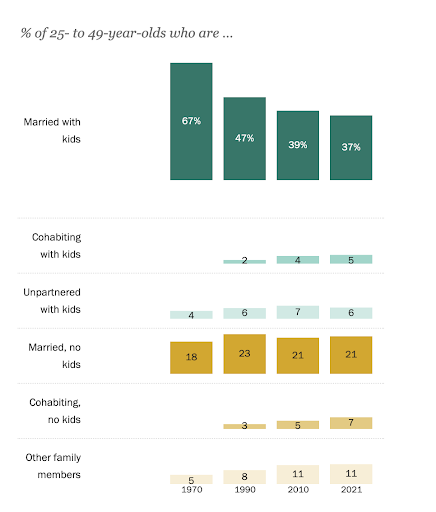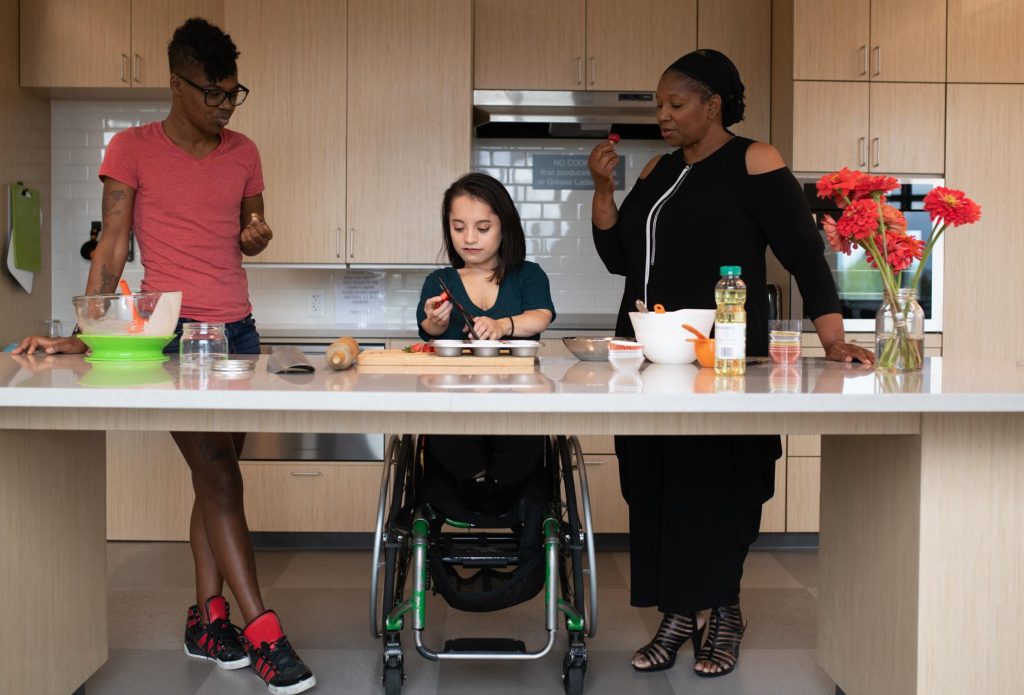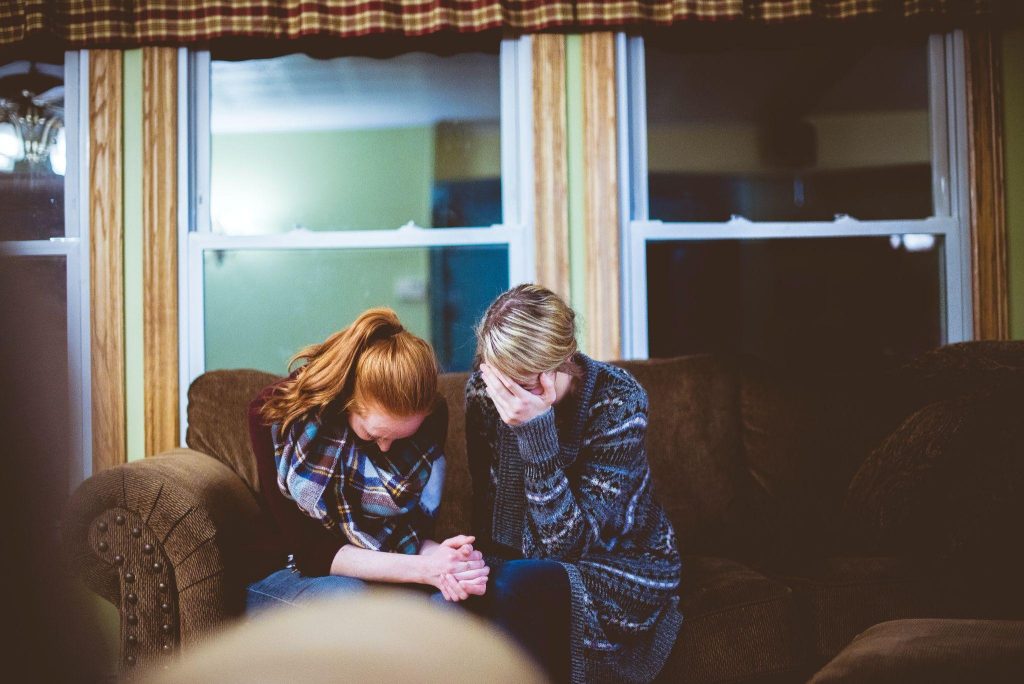Diversity of Families
The United States’ Census Bureau defines family as “…a group of two people or more (one of whom is the householder) related by birth, marriage, or adoption and residing together; all such people (including related subfamily members) are considered as members of one family.“ While this definition provides a framework for understanding family configurations in the United States over a period of time, it may not accurately represent the social and cultural factors that contextualize how we define “family” in our personal networks. It is restrictive and does not integrate the diversity of the modern family in the United States.
In 2023, the Pew Research Center released The Modern American Family: Key Trends in Marriage and Family Life. This document outlined key data points from 1970 that chronicles how the American “family” has evolved and changed.

Pause to Reflect!
- Choose one of the categories listed in the left hand column of the infographic.
- Describe how the data has evolved from 1970-2021.
- How does this data change or expand how we define “family”?
The Pew Research Center points to overall changes in marriage types from 1970-2021.
- The number of interracial or interethnic marriages have increased.
- The number of same-sex marriages have increased.
- Women have fewer children, resulting in smaller family sizes.
- The number of women having children without being legally married has increased.
- Individuals with a bachelor’s degree are more likely to be married than those with less education.
- Asian and White adults are more likely to be married than those who are Black or Hispanic.
Data trends are important in the field of Education and Child & Family Studies, as they point to the evolution of “family”, and therefore the need to continually examine the support structures, community centers or schools or early childhood centers, that surround families.
Pause to Reflect!
- Families often face discrimination about their family structure or values. For example. Same-sex families and a family with an incarcerated caregiver both experience discrimination. However, that discrimination “looks” different. Describe how diverse families experience discrimination in the United States.
- Navigate to The Modern American Family: Key Trends in Marriage and Family Life. At the bottom of the article, locate an interactive data tool that allows you to examine marriage structures in the United States. Use the filters to explore differences in family structures by race, education, or ethnicity. Describe what you explored. How does that information influence the design of support structures, like community centers or schools or early childhood centers?
Paul R. Amato, Ph.D., former President of the National Council on Family Relations, asks us to expand our definition of “family”. Amato states, “Most current research is based on objective definitions of families—definitions that are not shared by the majority of individuals that we study. Viewing families as overlapping networks that extend across multiple households, with each network having at its nucleus a reference person, might yield new insights, especially in an era when families are becoming more complex and difficult to classify.” Amato points to the complexity of “family” within a social construct. Amato’s perspective incorporates the idea of “fictive kinship.” “Fictive kinship” recognizes the important bonds and relationships of individuals outside of the boundaries of the traditional definition of “family.” The idea that an individual cannot pick their relatives does not apply to fictive kinship. Rather, fictive kinship honors the diversity of the definition of “family” in that it extends to friend groups, resource families, mentors, etc. The individual is at the center of the relationship and their “family” is self-defined based on their own social and cultural criteria.
Case Study (A)

Ella, a divorced mother lives with her child, Grace. Ella considers her ex-husband, Robert, to be a family member even though they do not live together and are divorced. Robert is Grace’s biological father. Grace spends every weekend with Robert, and oftentimes, Robert picks Grace up from school and has dinner with Ella and Grace during the week. Robert is important in Grace’s life and Ella supports his presence in her life.
- U.S. Census Bureau
A researcher who adopts the U.S. Census Bureau definition would say that Grace is in a single-parent family.
- Modern Families
A researcher who adopts a definition more consistent with an understanding of modern families would say that Grace would claim to be in a two-parent family.
Case Study (B)

Adam and Georgia are divorced parents of Allyson. Adam was recently remarried to Frank. They purchased a home together. Allyson lives with them and visits Georgia on the weekends and during school vacations. Allyson does not accept Frank as her parent and refuses to allow Frank to attend parent-teacher conferences at her school. She only wants Adam and Georgia to attend.
- U.S. Census Bureau
A researcher who adopts the U.S. Census Bureau definition would say that Allyson is in a two-parent family with Adam and Frank.
- Modern Families
A researcher who adopts a definition more consistent with an understanding of modern families would say that Allyson would claim to be in a two-parent family with Adam and Georgia.
Case Study (C)

Jordan and Aaron have been best friends since second grade. They are now 22 years old and are considering renting an apartment together while they attend the local community college. Growing up, Jordan spent more time at Aaron’s home than their own because it felt safer and supportive. Jordan currently lives with their mom and dad, but does not have a close relationship with them. Jordan considers Aaron’s parents their “real” family.
- U.S. Census Bureau
A researcher who adopts the U.S. Census Bureau definition would say that Jordan is in a two-parent family with their biological parents.
- Modern Families
A researcher who adopts a definition more consistent with an understanding of modern families would say that Jordan would claim to be in a two-parent family with Aaron’s family, or might claim to be an independent person getting ready to move out on their own.
Pause to Reflect!
Discuss the following questions
- What does family mean to you? Who do you think of when you define family?
- Do you see your family represented in the “dominant culture”?
- Identify a minimum of three concrete examples of ways that the idea of “fictive kinship” connects to your professional or personal life.
A social construction is a mutual understanding and accepted reality created by members of a society: something that is not determined by biology or the natural world. Is there anything that humans have created that holds no real value in the natural world, yet we have assigned a great deal of value to it? If you are thinking of cash, you’re right on the money. Humans have determined that certain pieces of paper and metal objects are worth an agreed-upon value. For example, in the United States, a one-dollar bill is worth 100 times the value of a penny. One of the ways that we can tell money is a social construction is that it varies from culture to culture and over time. When you visit another country, the United States dollar bill has to be “exchanged” for money that has a different appearance and value. Compare money with another thing of value to human beings: air. Air is needed by all human beings to survive. The need for air and its value do not change over time or from culture to culture. Air is not a social construction. Money is.
What does this have to do with families? While studying families, we must continually remind ourselves that the idea of the family, and in particular the internalized belief that there is a “traditional family,” is a social construction. What is a “traditional family”? I suspect that we can each paint a picture in our heads, based on the years each of us has been exposed to portrayals of families in institutions such as the media, schools, government, and health care.
 Generally, the traditional American family has been identified as the nuclear family, most often represented as a male and female heterosexual married couple who is middle class, White, and with several children. When society or the individuals within a society designate one kind of family to be “traditional”, this may imply a value, or a preference, for this kind of family structure with these particular social characteristics. This is sometimes called the Leave it to Beaver family after the popular sitcom television show that ran from 1957 until 1963.
Generally, the traditional American family has been identified as the nuclear family, most often represented as a male and female heterosexual married couple who is middle class, White, and with several children. When society or the individuals within a society designate one kind of family to be “traditional”, this may imply a value, or a preference, for this kind of family structure with these particular social characteristics. This is sometimes called the Leave it to Beaver family after the popular sitcom television show that ran from 1957 until 1963.
Friends, which concluded its 10th season in 2004, exemplifies a fictive kinship. The comedy presents a peer group of individuals in their 20s who live in New York City. The six main characters are best friends who enjoy holidays together, date each other, and remain close friends with one another as they age into their 30s. While they do not all live together in the same apartment, they consider themselves a family.

New Girl, which concluded its 7th season in 2018, also exemplifies a fictive kinship. The comedy presents a peer group of individuals in their 20s who live in Los Angeles. Like in Friends, the five main characters are best friends who enjoy holidays together, date each other, and remain close friends with one another as they age into their 30s. With the exception of one character, they all live together in the same apartment, they consider themselves a family. In fact, two of the five characters marry one another.

Modern Family, which concluded its 11th season in 2020, also features this “traditional” family, but includes two other families which feature people of other ethnic groups, and a same-sex couple. Together they form an extended family who all live in the same town. 
This is Us, which concluded its 6th season in 2022, also features this “traditional” family, but includes two adopted children and a mixed-race, multigenerational family. It also extends its story to include adoption, death, divorce, separation, and remarriage.

IIt is important to note, however, that the primacy of the upper-middle-class, White family image continues to be emphasized as the “norm”. Our role is to look at how this social construct impacts the way in which children, families, schools, and communities interact with one another in respectful ways that are culturally responsive, honor the diversity of the family structure, and include a vision of fictive kinship in their collaborations.
Pause to Reflect!
- Identify a family or fictive kinship in a current show or movie. Describe how that family representation aligns or misaligned with the data discussed earlier in this chapter from the Pew Research Center?
- Provide three examples of a non traditional family dynamic within a book, a movie, tv show, or other form of entertainment and media.
The traditional definition of family has been criticized as being too narrow. Modern families, especially those in industrialized societies, exist in many forms, including (but not limited to) the single-parent family, resource families, same-sex couples, child-free families, and many other variations from traditional norms. Common to each of these family forms is commitment, caring, and the close emotional ties that are increasingly the defining characteristics of family (Benokraitis, 2015). The changing definition of family has come about, in part, because of many factors that include divorce and remarriage. In many cases, people do not grow up with their family of origin but become part of a step-family or blended family. Whether a single-parent, joint, or two-parent family, a person’s family of origin, the family into which he or she is born, or a fictive kinship generally acts as the social context for young children learning about relationships.
As we study families, we must keep in mind that this idea of the “traditional” family is not representative of all families, yet it is continually reinforced by the social processes and institutions in our society. Media, in particular, continually reminds us of what families are “supposed to” look like. Whether you consume big-budget films, social media platforms, video games, and/or books and magazines, take a look. What kind of people and families do you see represented? While the representation of women, people of color, and people of differing sexualities and gender expressions has increased in media, they still predominantly play less consequential characters within the plot lines. Government, schools, medical institutions, businesses, and places of worship all reinforce a typical view of family through the forms, activities, requirements, and processes that are shared with the public. How many times have you tried to fill out a form with checkboxes only to find that you did not “fit” into one of the boxes? Typical examples include giving parental choices of “mother” and “father,” couple status choices such as “married” or “single,” and gender choices such as “male” or female,” all of which reinforce a binary view of individuals and families. The preference for an idealized traditional family type contributes to less social support for families who don’t fit this type: for example, single-parent families, LGBTQ+ families, rural families, or families with a member who is disabled, unemployed, or who has a criminal record.
Pause to Reflect!
Research and discuss the following questions.
- Identify two official forms that a family member may fill out on behalf of a child. Examples might include a school district enrollment form, Head Start enrollment form, or a form for a pediatrician or other medical professional.
- Examine the forms for inclusive language. Do they include the parental choices of “mother” and “father” or are they more flexible in their labels of parents, guardians, and/or other caregivers?
- If the forms are not inclusive, edit them.
Media Attributions
- 5 of 25- to 49-year olds charts © Daily Citizen is licensed under a CC BY-SA (Attribution ShareAlike) license
- Family making a snack © Chona Kasinger is licensed under a CC BY (Attribution) license
- A mother and teenager © Ben White is licensed under a CC0 (Creative Commons Zero) license
- Young adults reading © Zachary Drucker is licensed under a CC BY-NC-ND (Attribution NonCommercial NoDerivatives) license
- Leave it to Beaver © ABC Television is licensed under a Public Domain license
- Friends © GamesRadar is licensed under a All Rights Reserved license
- New Girl © University of California at San Diego’s Guardian is licensed under a All Rights Reserved license
- Modern Family © ABC is licensed under a All Rights Reserved license
- This is Us © NBC is licensed under a All Rights Reserved license

